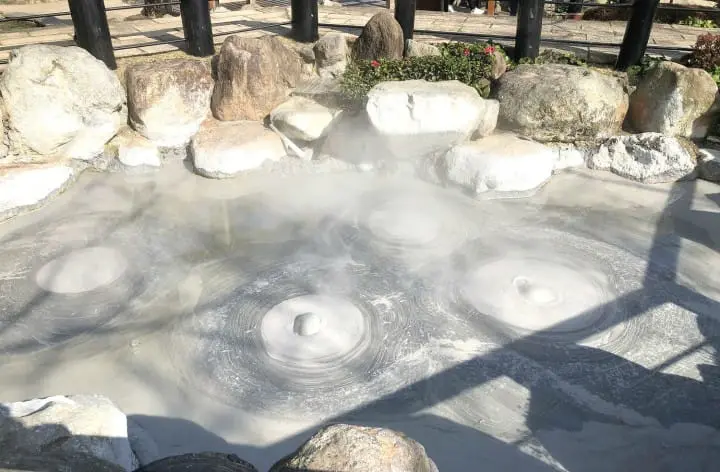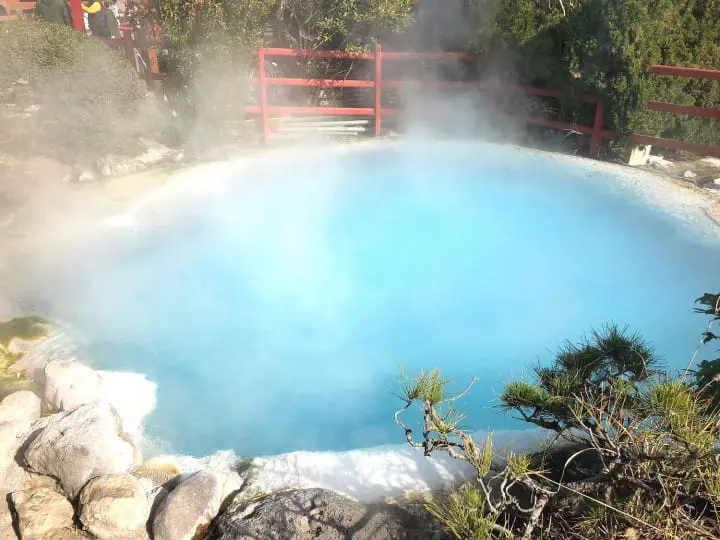Japan, Off The Beaten Path (1) - To Heaven And Hell In Beppu

“Japan, Off The Beaten Path” is a travel essay series by Susan Spann, author of the Hiro Hattori mystery novels. In this first installment, she tells us about her trip to Beppu in Oita Prefecture and the otherworldly sights she encountered there.

Umi Jigoku (“Ocean Hell”)
Japan has many famous onsen (volcanic hot spring) towns, but when I heard that Beppu, on the northeast coast of Kyushu, gave visitors the chance to experience both heaven and hell in a two-day trip, I had to go and see it for myself.
I arrived in the coastal city, which sits an hour by train from Kita-Kyushu, in Oita Prefecture, just before noon on a chilly but sunny Tuesday afternoon at the end of January. When possible, I visit popular tourist destinations during the week, to avoid the weekend crowds and find better rates at hotels and ryokan (traditional Japanese inns), like Beppu’s Umikaoruyado Hotel Newmatsumi, where I’d booked a room with a private onsen tub and an ocean view.
After leaving my luggage at the ryokan, I walked two blocks to the bus depot and hopped the lunchtime bus to hell.
Beppu’s famous “hells” (“jigoku” in Japanese) are seven volcanic hot springs, each with unique properties that make them unsuitable for bathing but spectacular to see.

Oniishi Bozu Jigoku
I began my “hell tour” in the Kannawa district, where I walked from the bus stop to the first of the five Kannawa hells: Oniishi Bozu Jigoku, named for the rounded bubbles that emerge from its pools of boiling white clay and resemble the round, bald heads of Buddhist monks.
After touring the hell, I stopped at an open-air restaurant just outside to sample a local specialty known as jigoku mushi (hell cuisine): food cooked in the boiling steam that rises from the famous hells. While several area restaurants give visitors the chance to cook their own jigoku mushi meals, I opted for a “hell bun” cooked by the staff outside Oniishi Bozu Jigoku. The tender, slightly sweet steamed bread was stuffed with tangy, savory chicken and vegetables.
For dessert, I tried “jigoku purin” (hell-steamed pudding), a Beppu specialty consisting of eggs, sugar, and cream steamed in the vents of Beppu’s famous hells. Its taste and texture reminded me of flan, or caramel custard, and I easily could have eaten four or five—but since I wanted to save room to try some other local dishes, too, I stopped after only one.

The Blue Pool of Kamado Jigoku
With my hunger temporarily sated, I visited the brilliant blue-green Umi Jigoku (“Ocean Hell”), and Kamado Jigoku (“Cooking Pot Hell”) where I inhaled the healing steam and enjoyed a hard-boiled egg cooked in the water of the boiling pool, which emerges from the ground at 90 degrees Celsius (194° Fahrenheit). Minerals in the water gave the egg an unusually earthy taste, and turned the egg whites pale brown in color.

Oniyama Jigoku
Kannawa’s last two hells both featured animals: a crocodile breeding farm in the steaming waters of Oniyama Jigoku (“Crocodile Mountain Hell”) and freshwater aquariums at Shiraike Jigoku (“White Pond Hell”) heated by the volcanic spring and filled with giant piranha and pirarucu (another carnivorous fish from the Amazon). I didn’t find anything new to eat at either place—but I didn’t get eaten either, which I counted as a win.
From there, I hopped a ten-minute taxi ride to Beppu’s Shibaseki district for a visit to the last two hells: blood-red, boiling Chinoike Jigoku (“Blood Pond Hell”) and Tatsumaki Jigoku (“Spouting Hell”), whose famous geyser erupted the moment I walked through the door. How’s that for timing?
Tatsumaki Jigoku erupts several times an hour, with a rare regularity sometimes compared to “Old Faithful,” in the USA’s Yellowstone National Park.
After a dinner of local dumplings and Beppu’s chicken tempura specialty known as toriten, I returned to my ryokan, filled the deep stone tub on my balcony, and watched the stars come out above Beppu Bay as I soaked my tired muscles in the steaming volcanic waters of Beppu Onsen.
The following morning, I watched the glowing orange sun rise over the pale gray sea as fishermen rowed their boats in the waters just offshore. The temperature felt comfortable, but I packed an extra sweater, winter gloves, and a knitted hat in my backpack, and donned my down ski jacket, anticipating my visit to “heaven,” atop nearby Mt. Tsurumi, would be colder than yesterday’s trip to hell.

View from Beppu Ropeway
The 9:35 a.m. bus to the Beppu Ropeway was much emptier than I expected.
Apparently, as between heaven and hell, hell is a bigger tourist draw.
Located on the eastern end of Aso-Kuju National Park, the Kintetsu Beppu Ropeway carries visitors about ¾ of the way to the top of sacred Mt. Tsurumi (1,374 m).

Ichinomiya Gongen Shrine on the summit of Mt. Tsurumi
From the upper gondola station, visitors can hike the remaining 20-30 minutes to the summit or take a slightly longer pilgrimage around the mountain’s upper slopes to visit a series of shrines dedicated to the Seven Lucky Gods of wisdom and good fortune.

As the gondola moved up the mountain, patches of snow appeared on the mountainside, and at the upper station I disembarked into a winter wonderland covered in sparkling snow. Cold winds blew across the mountain, making me glad I’d packed my hat and gloves. Ten minutes into the climb, I also stopped to strap a set of snow spikes on my hiking boots to prevent a dangerous slip on the icy slopes. With the spikes in place and my footing secure, I continued up the trail.

The air smelled fresh and cool, and sunshine glittered on the snow. My boots crunched softly as I hiked first to the summit and then along the pilgrimage route to visit the lucky gods. Only a few other people braved the snow that day, though someone had left small yuki daruma (snowmen) as offerings on several of the shrines.

View from the summit of Mt. Tsurumi
At the end of the hike, I sat on a sun-warmed wooden bench and enjoyed the spectacular view of Beppu and the sea as I ate a bento lunch (and another hell-steamed pudding) that I’d carried up the mountain in my pack. The clean white snow spread out around me, adding to the sensation that I really had stopped for lunch at heaven’s gates.
My time in Beppu went by quickly, but I savored every moment, from the delicious treats at Beppu’s hells to the glittering, pristine snow on Mt. Tsurumi—and now I can say that I’ve been to heaven, and to hell, in only two days’ time.
Text and photos by Susan Spann
Susan Spann is the author of the Hiro Hattori mystery novels. She lives in Tokyo, but frequently travels across Japan, climbing mountains and seeking adventures off the beaten path. You can find her online at www.susanspann.com
Susan Spann is the author of the Hiro Hattori mystery novels. She lives in Tokyo, but frequently travels across Japan, climbing mountains and seeking adventures off the beaten path. You can find her online at www.susanspann.com.






































![[2026] Top 5 Strawberry Picking Spots in Tokushima, Naruto| Farms and Access Guide for January to May](https://resources.matcha-jp.com/resize/720x2000/2025/03/06-227165.webp)
![[Yamanashi/ Hokuto City] 4 Hot New Spots Opening in 2026](https://resources.matcha-jp.com/resize/720x2000/2025/12/12-252747.webp)


